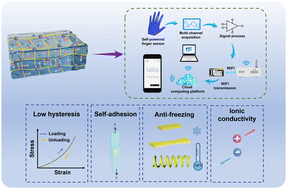The fabrication of stretchable ionic conductors with low hysteresis and anti-freezing properties to enhance the durability and reliability of flexible electronics even at low temperatures remains an unmet challenge. Here, we report a facile strategy to fabricate low hysteresis, high stretchability, self-adhesion and anti-freezing zwitterionic supramolecular polymer ion-conductive elastomers (ICEs) by photoinitiated polymerization of aqueous precursor solutions containing a newly designed zwitterionic monomer carboxybetaine ureido acrylate (CBUIA) followed by solvent evaporation. The resultant poly(carboxybetaine ureido acrylate) (PCBUIA) ICEs are highly stretchable and self-adhesive owing to the presence of strong hydrogen bonds between ureido groups and dipole–dipole interactions of zwitterions. The zwitterion groups on the polymer side chains and loaded-lithium chloride endow PCBUIA ICEs with excellent anti-freezing properties, demonstrating mechanical flexibility and ionic transport properties even at a low temperature (−20 °C). Remarkably, the PCBUIA ICEs demonstrate a low hysteresis (≈10%) during cyclic mechanical loading–unloading (≤500%), and are successfully applied as wearable strain sensors and triboelectric nanogenerators (TENGs) for energy harvesting and human motion monitoring. In addition, the PCBUIA ICE-based TENG was used as a wireless sensing terminal for Internet of Things smart devices to enable wireless sensing of finger motion state detection.
